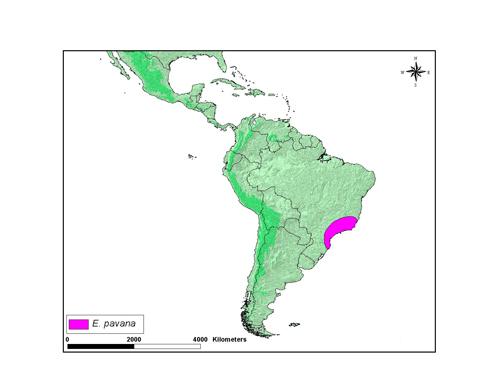Eueides pavana
Margarita BeltránIntroduction
Etymology: Pavana or Vayu is a sacred hindu name. God of wind or air is a fierce god. He drives his horses furiously, sometimes a thousand of them. He is thought of as the god of rapid motion and therefore the father of the fleet-footed (Vayu).
Characteristics
Early stages: Eggs white and approximately 1 x 0.8 mm (h x w). Females usually place 1 to 10 eggs under older leaves of the host plant. Mature larvae have a green and yellow body with black spots and stripes, with black scoli and orange head; length is around 1 cm. Caterpillars are gregarious (Brown, 1981).
Geographical distribution
Eueides pavana is distributed in South Brazil. The map below shows an approximate representation of the geographic distribution of this species. The original data used to draw these maps are derived from Brown (1979) which is available at Keith S. Brown Jr. (1979). Ecological Geography and Evolution in Neotropical Forests.
Habits
E. pavana occurs from sea level to 1,500 m in montane forests. Usually individuals fly slowly in the canopy. The males sit on female pupae a day before emergence, and mating occurs the next morning, before the female has completely eclosed (Brown, 1981).
Hostplant: E. pavana larvae feed primarily on plants from the genus Passiflora subgenus Astrophea and Polyanthea (Brown, 1981).
References
Brown K. S. 1979. Ecologia Geográfica e Evolução nas Florestas Neotropicais. 2 vols. (Tese apresentada à Universidade Estadual de Campinas como parte das exigências de um Concurso de Livre Docência, area de Ecologia). Universidade Estadual de Campinas, Campinas, Brazil.
Brown K. S. 1981 The Biology of Heliconius and Related Genera. Annual Review of Entomology 26, 427-456.
Ménétriés E. 1857 Enumeratio corporum animalium Musei Imperialis Academiae Scientiarum Petropolitanae. Classis insecto-rum. Ordo lepidopterorum. Petropoli, Eggers et Soc.; Lipsiae, Leop. Voss. 1: xv + 1-66 + 67-97 + [2] pp., pls. 1-6 (December 1855); 2: vi + 67-112 + [2] + 99-144 + [2] pp., pls. 7-14 (September 1857)
Vayu. Indian Divinity. http://www.webonautics.com/mythology/vayu.html [Accessed Aug 16, 2008]
About This Page
Margarita Beltrán

University of Cambridge, Cambridge, UK
Correspondence regarding this page should be directed to Margarita Beltrán at
beltran.margarita@gmail.com
Page copyright © 2009 Margarita Beltrán
 Page: Tree of Life
Eueides pavana .
Authored by
Margarita Beltrán.
The TEXT of this page is licensed under the
Creative Commons Attribution-NonCommercial-ShareAlike License - Version 3.0. Note that images and other media
featured on this page are each governed by their own license, and they may or may not be available
for reuse. Click on an image or a media link to access the media data window, which provides the
relevant licensing information. For the general terms and conditions of ToL material reuse and
redistribution, please see the Tree of Life Copyright
Policies.
Page: Tree of Life
Eueides pavana .
Authored by
Margarita Beltrán.
The TEXT of this page is licensed under the
Creative Commons Attribution-NonCommercial-ShareAlike License - Version 3.0. Note that images and other media
featured on this page are each governed by their own license, and they may or may not be available
for reuse. Click on an image or a media link to access the media data window, which provides the
relevant licensing information. For the general terms and conditions of ToL material reuse and
redistribution, please see the Tree of Life Copyright
Policies.
- First online 18 February 2007
- Content changed 04 September 2008
Citing this page:
Beltrán, Margarita. 2008. Eueides pavana . Version 04 September 2008 (under construction). http://tolweb.org/Eueides_pavana/72958/2008.09.04 in The Tree of Life Web Project, http://tolweb.org/








 Go to quick links
Go to quick search
Go to navigation for this section of the ToL site
Go to detailed links for the ToL site
Go to quick links
Go to quick search
Go to navigation for this section of the ToL site
Go to detailed links for the ToL site